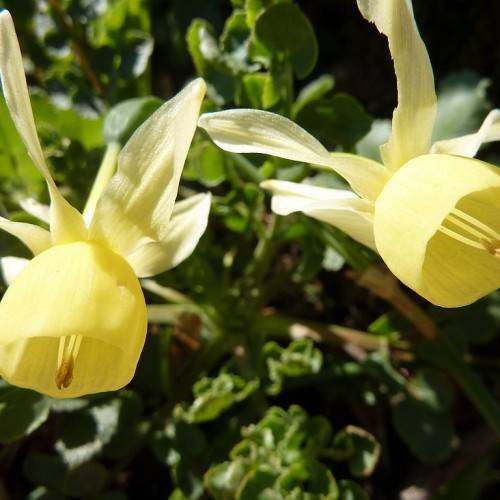
bulbocodium daffodil
Narcissus triandrus
Cycle:
Perennial
Watering:
Average
Hardiness Zone:
4 - 9
Flowers:
Flowers
Sun:
Full sun,part shade
Leaf:
Yes
Growth Rate:
Low
Maintenance:
Low
Salt Tolerant:
Yes
Care Level:
Medium
watering
Bulbocodium daffodils (Narcissus triandrus) should be watered regularly. Keep the soil evenly moist and never let it dry out completely. Water the bulbs deeply once a week, either in the morning or late afternoon, and give the soil a thorough soaking until water begins to drain out. During very hot and sunny weather, additional water may be necessary, and the soil should be monitored to check if it is drying out. During the winter dormancy period of the plant, water only when the soil feels dry. After flowering has finished, Bulbocodium daffodils should receive less water as this will help the bulb to recharge.
sunlight
Bulbocodium daffodil, also known as Narcissus triandrus, is a species of daffodil native to the Mediterranean region. Due to its hardy, easy-to-grow nature, it is a popular choice for many gardeners. The bulbocodium daffodil needs a considerable amount of sunlight in order to thrive. During the flowering season, it requires at least 6 hours of direct sunlight each day. Varieties with white and yellow blooms will perform best when exposed to as much sunlight as possible. Although direct sunlight is beneficial to bulbocodium daffodils, they do not need to be in direct sunlight all day long. Four to 6 hours per day is enough to keep the flowers in full bloom. If temperatures in the area are hot, the plants may need protection from direct sunlight during the hottest period of the day. In the wintertime, the bulbocodium daffodil needs less sunlight. The plant can thrive on just 4 hours per day, provided that temperatures are cool enough and the plant is receiving at least some indirect sunlight. To protect the plant from too much chilly weather, cover it with burlap or a breathable fabric. When planted in the right conditions, the bulbocodium daffodil can be an attractive addition to any garden. With the right amount of sunlight, it will stay healthy and bloom even in cold climates.
pruning
Bulbocodium daffodil (Narcissus triandrus) should be pruned once the foliage of the plant begins to yellow and die off after flowering in spring, usually in late April or early May. Pruning should be done conservatively, as removing too much foliage may limit flowering in subsequent years. Trim off the flower stems at the base of the plant, leaving a 2-3 inch stub. If seed pods have formed, remove them also. If wider pruning is needed to rejuvenate the plants, it should be done in the fall after the foliage has died back. Lightly prune back the entire plant by 1/3 to 1/2 its size. Leaves can be cut back to the base if necessary.
